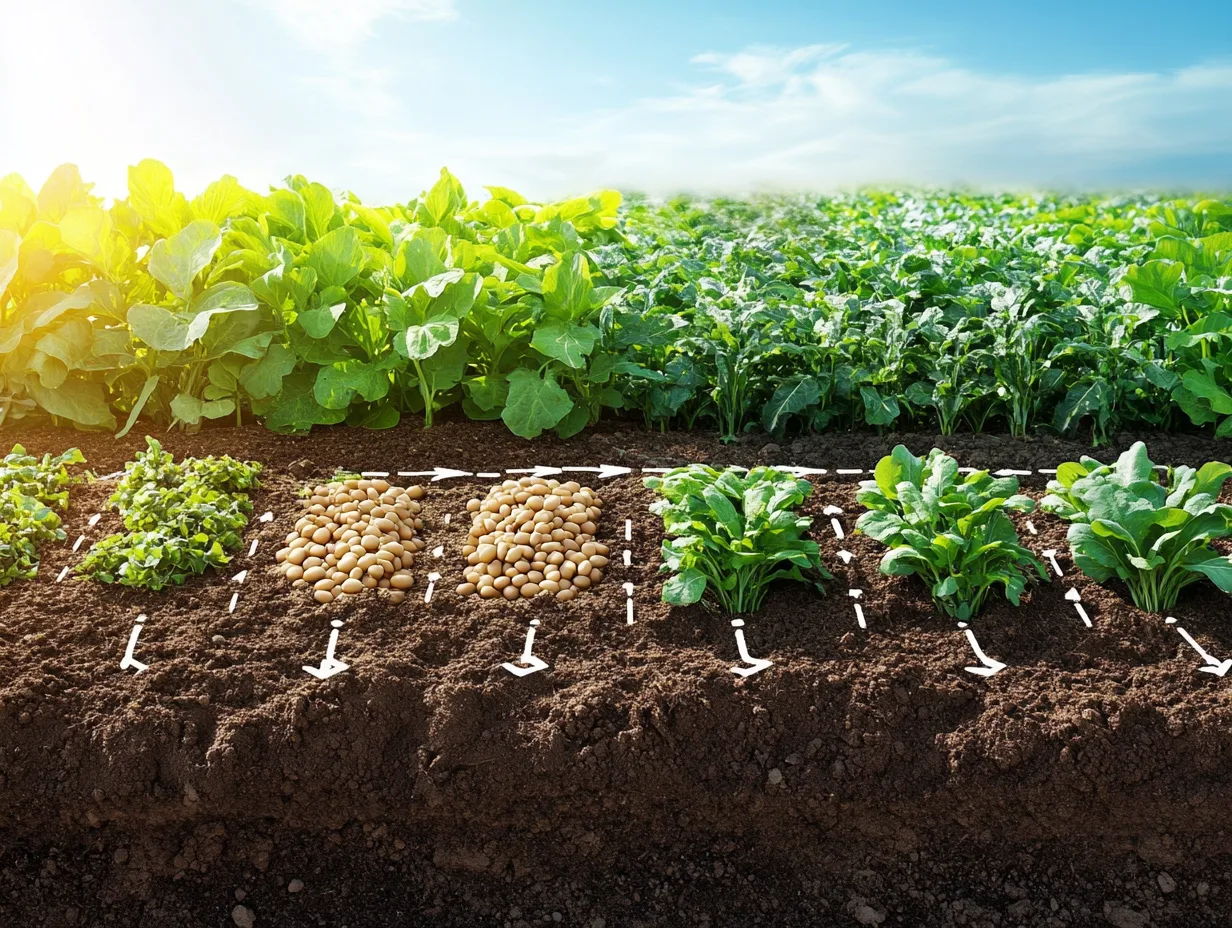Boosting Soil Health and Yield
Picture yourself stepping into a lush, thriving vegetable garden where each season brings fresh, vibrant produce. Achieving this ideal scenario often involves more than just attentive watering and weeding. In fact, one of the most impactful strategies for maintaining long-term garden productivity is crop rotation. Welcome to The Essential Guide to Crop Rotation, where you’ll discover how rotating your crops not only improves soil health but also increases your yield over time. By understanding the principles behind this centuries-old practice, you can nurture a more sustainable, resilient, and productive garden for years to come.
Understanding the Basics of Crop Rotation: Building a Strong Foundation
Before diving into more complex strategies, it’s important to understand what crop rotation is and why it matters. In essence, crop rotation involves systematically changing which plants grow in a given area from one season or year to the next. This practice helps maintain soil fertility, reduce pest populations, and ultimately boost your harvest.
Why Is Crop Rotation Important for Your Garden?
Rotating your crops breaks the life cycles of pests and diseases that tend to attack specific plant families. By not planting the same crop in the same spot year after year, you deprive pests of their preferred hosts, naturally minimizing infestations and disease pressure. Additionally, different plants have varying nutrient needs. When you rotate crops with distinct nutritional demands, you help balance soil fertility and reduce nutrient depletion, ultimately leading to healthier, more productive soil.
Key Reasons to Embrace Crop Rotation:
- Disrupts pest and disease cycles
- Enhances soil fertility and structure
- Optimizes nutrient use and reduces erosion
- Promotes biodiversity in your garden ecosystem
For a deeper look into improving your soil’s nutrient profile, visit our post on The Science of Soil: Understanding and Improving Soil Composition for Better Yields.
The Four-Crop Rotation System: A Simple, Time-Tested Approach
One of the most common frameworks for implementing crop rotation is the four-crop system. Though there are countless variations, this classic method categorizes crops into four main groups based on their nutrient requirements and growth habits.
The Four Major Crop Groups to Consider
- Legumes (e.g., Peas, Beans):
These nitrogen-fixing plants improve soil fertility by converting atmospheric nitrogen into a form that other plants can use. - Leafy Greens and Brassicas (e.g., Lettuce, Spinach, Broccoli, Cabbage):
These heavy feeders require abundant nitrogen for vigorous growth, making them ideal candidates to follow legumes. - Fruiting Vegetables (e.g., Tomatoes, Peppers, Eggplants, Cucumbers):
These crops extract phosphorus and potassium from the soil and benefit from the balanced soil conditions created by earlier rotations. - Root Crops (e.g., Carrots, Beets, Onions, Garlic):
Root vegetables benefit from well-aerated soil enriched by previous rotations, while their relatively low nutrient demands help maintain soil health.
By cycling through these groups in a logical sequence (e.g., legumes → leafy greens → fruiting vegetables → root crops), you can create a balanced rotation that naturally restores soil nutrients and reduces pest problems.
Tailoring Crop Rotation to Your Specific Needs: Flexible Strategies for Any Garden
No two gardens are exactly alike, and the best crop rotation plan is the one that adapts to your unique conditions. Factors like climate, garden size, crop preferences, and soil type influence how you design your rotation.
Adapting Crop Rotation for Small Spaces
If you’re working with a limited area—like a raised bed or a small urban plot—you can still rotate your crops effectively. Instead of dedicating large sections to each group, you might interplant multiple crops together and adjust your plan season-by-season. For inspiration on maximizing productivity in small spaces, check out our post on Innovative Container Gardening: Growing Vegetables in Small Spaces.
Adjusting Your Rotation for Climate and Soil Conditions
In colder climates with shorter growing seasons, you may need to select faster-maturing varieties or rely on cover crops to maintain soil health between harvests. In warmer climates, multiple growing cycles per year could allow for more frequent rotations. Pay attention to your local conditions and experiment to find the best rotation patterns.
Pest and Disease Management: Breaking the Cycle Through Crop Rotation
One of the greatest benefits of crop rotation is reducing the likelihood of persistent pests and diseases that can devastate your harvest. By rotating crops, you interrupt their life cycles, making it harder for these unwanted visitors to gain a foothold in your garden.
Common Pests and Diseases Controlled by Rotating Your Crops
- Nematodes: These microscopic worms thrive in soil planted repeatedly with the same crop. Switching to a different plant family helps keep their populations in check.
- Soil-Borne Fungi and Bacteria: Pathogens that target specific crops weaken when their preferred host isn’t present year after year.
- Leaf-Chewing Insects: Moving crops makes it difficult for insects to locate their favorite meals, reducing damage.
For more natural strategies to protect your plants, consider reading our article on Eco-Friendly Pest Control: Natural Solutions for Healthy Vegetable Gardens.
Improving Soil Fertility and Structure Through Crop Rotation
Over time, relying on a single crop type can drain specific nutrients from the soil, leaving it depleted and compacted. A well-planned crop rotation strategy introduces diversity, encouraging beneficial soil organisms to thrive and improving both fertility and structure.
Nutrient Cycling: The Secret to Long-Term Soil Health
Different plants draw from different nutrient pools in the soil. Legumes, for instance, add nitrogen, while deep-rooted crops bring nutrients from deeper soil layers closer to the surface. By alternating plant families, you ensure that no single nutrient source is overexploited. This balanced approach reduces the need for synthetic fertilizers and creates a naturally fertile environment.
Tips for Enhancing Soil Fertility with Crop Rotation:
- Include Legumes: Incorporate nitrogen-fixing crops like beans and peas into your rotation.
- Use Green Manure: Consider planting cover crops that enrich the soil with organic matter. For guidance on composting and organic amendments, check out Composting 101: Transforming Kitchen Waste into Garden Gold.
- Rotate Deep-Rooted and Shallow-Rooted Crops: Varying root depths improve soil aeration and nutrient distribution, promoting a stable, balanced soil ecosystem.
Maximizing Garden Yield and Crop Quality by Rotating Your Crops
A well-planned crop rotation doesn’t just benefit your soil and reduce pest pressure—it also directly impacts the quality and quantity of your harvest. Healthier soil nurtures more vigorous plant growth, leading to higher yields and tastier, more nutritious produce.
How Crop Rotation Leads to Better Harvests
- Steadier Plant Growth: Plants receive a balanced nutrient supply, reducing stress and encouraging robust development.
- Fewer Chemical Inputs: With fewer pests and diseases, you’ll rely less on pesticides and chemical fertilizers, resulting in cleaner, healthier crops.
- Improved Water Efficiency: Healthy, well-structured soil retains moisture more effectively, reducing water waste and ensuring consistent hydration for your plants.
Planning Your Crop Rotation Schedule: Practical Steps for Getting Started
Taking the time to develop a clear crop rotation plan simplifies the process and helps you stay organized. Once you understand which plant families to include and how to arrange them, you can create a rotation schedule that suits your garden’s unique conditions.
Steps for Implementing a Successful Crop Rotation
- Identify Your Key Crops: Start by listing the plants you grow most frequently. Group them by botanical family (e.g., nightshades, brassicas, legumes).
- Map Your Garden: Sketch a simple layout of your garden beds or containers. Assign each area a specific plant family for the upcoming season.
- Set a Rotation Cycle: Determine how many years you’ll wait before returning the same crop family to the same bed. Many gardeners opt for a three- or four-year rotation cycle, but shorter or longer rotations can also work.
- Record Your Results: Keep notes on what you plant, where you plant it, and how the crops perform. Over time, this record will help you refine your rotation strategy.
Integrating Cover Crops and Green Manure into Your Rotation Plan
Cover crops—also known as green manure—are an excellent addition to any crop rotation plan. Planted in the off-season, these crops protect the soil from erosion, suppress weeds, and add organic matter when tilled under. Integrating cover crops can further enhance the benefits of crop rotation, improving soil health and reducing resource inputs.
Popular Cover Crops to Consider
- Clover and Vetch: Nitrogen-fixing legumes that improve soil fertility.
- Rye and Oats: Grasses that add organic matter, helping build soil structure.
- Buckwheat: A fast-growing cover crop that smothers weeds and improves soil tilth.
For more detailed advice on sustainable soil amendments, explore our article on DIY Homemade Fertilizer: Turning Kitchen Scraps into Nutrient-Rich Soil.
Seeking Expert Guidance and Resources to Refine Your Crop Rotation Skills
As you deepen your understanding of crop rotation, you may encounter challenges or questions. Consulting reputable resources can help you make informed decisions and adapt your rotation plan as conditions change.
Reliable Sources of Information
- University Extension Services: Local extension offices often provide region-specific advice and research-based best practices. For example, the Penn State Extension offers valuable insights on crop rotation and soil health.
- USDA Resources: The U.S. Department of Agriculture and related organizations provide expert guidance on sustainable agriculture techniques, including crop rotation.
- Online Gardening Communities: Forums, social media groups, and gardening clubs are excellent places to share experiences, exchange tips, and learn from fellow growers.
Refining and Evolving Your Crop Rotation Plan Over Time
Crop rotation is not a “set it and forget it” strategy. Over the years, your garden’s conditions will evolve—soil quality may improve, pest pressures may shift, and your choice of crops might change. By remaining flexible and attentive, you can refine your rotation plan to keep pace with these developments.
Continuous Improvement for Long-Term Success
- Monitor Soil Health: Regularly test your soil’s pH and nutrient levels to ensure it’s meeting your plants’ needs.
- Observe Plant Performance: Take note of signs like stunted growth, discoloration, or pest activity, adjusting your rotation plan accordingly.
- Experiment and Learn: Don’t hesitate to try new crops, cover crops, or rotation patterns. Over time, your experience and observations will guide you toward the most effective strategies.
Embracing The Essential Guide to Crop Rotation can transform your approach to gardening. By understanding the principles behind rotating your crops, you’ll cultivate a garden that’s more resilient, resource-efficient, and productive. This time-tested practice not only enriches your soil and reduces pests but also leads to healthier plants, better yields, and a more sustainable gardening experience. As you continue to refine your strategy and learn from each growing season, you’ll unlock the full potential of crop rotation—turning your garden into a thriving, ever-improving ecosystem.


Leave a Reply